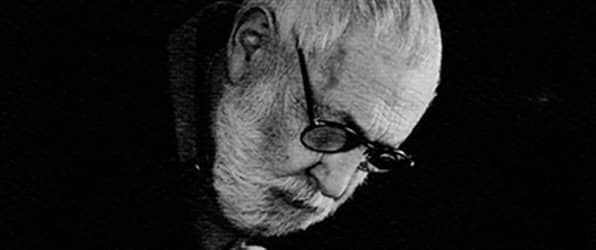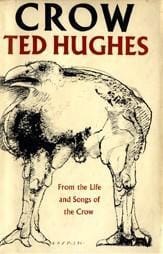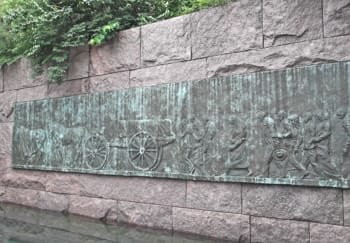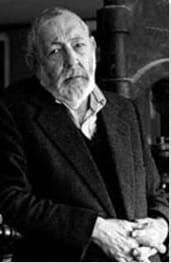Summary of Leonard Baskin
Baskin has been described as "the last great renaissance men" of his generation. His talent shone its light on many different fields of the visual arts, but he remains most admired for his intense and impassioned figurative prints and book illustrations, and his sculptures. Many of his works referenced biblical parables, ancient Egyptian and Greek mythology, literature, and Jewish history. He also established one of the most prestigious, and longest running, independent fine art presses.
Accomplishments
- Baskin's illustrations conveyed a raw intensity. Taking his inspiration from the likes of William Blake, he created ink drawings and watercolors that were both disturbing and grotesque. His illustrations were often juxtaposed with texts that alluded to his strict Orthodox Jewish upbringing. He illustrated the works of some of the 20th century's greatest poets, including Ted Hughes, Sylvia Plath, and (posthumously) James Baldwin.
- Baskin was amongst the first modern artists to create life-size woodprints. Works such as Man of Peace (1952) and Hydrogen Man (1954) feature metaphorical human figures who have been severely disfigured. Through his use of the positive and negative space afforded by the woodcut medium, his figures possess a hollowed-out quality that spoke of the artist's feeling of despair towards human brutality.
- Strongly influenced by the German Expressionist sculptor, Ernst Barlach, Baskin produced sculptures executed in bronze, limestone, and wood. His human figures tended to embody a tortured vulnerability which Baskin saw as a condition of 20th century living. Baskin was especially respected for his work on monuments, including the bronze Holocaust Memorial in Ann Arbor, Michigan, which features a 7-foot seated figure which symbolized at once raw anger, and forgiveness and tenderness.
- Baskin was the founder of The Gehenna Press, one of America's first limited edition fine art presses. He pioneered a new method of bookbinding and typesetting, turning the act of publishing into an artform in its own right, with the Press gaining recognition for superb workmanship and its sophisticated and elegant choice of typeface. The Press published over 200 books in its 60 years history, representing artists, poets, and writers from different spheres, and is widely considered the most successful private press of all time.
The Life of Leonard Baskin

Baskin was captivated by the nature of humankind: "Glorious in defining our universal sodality and glorious in defining our utter uniqueness", he wrote, "The human figure is the image of all men and of one man. It contains all and can express all."
Important Art by Leonard Baskin
Hydrogen Man
Baskin began experimenting with large scale woodblock printing in the early 1950s. He was among the earliest modern artists to create life-size prints of metaphorical human figures. Hydrogen Man is a prime example of the humanist themes running through Baskin's art. The print is haunting in its depiction of a partially disintegrated, and severely disfigured, man. Baskin utilized the positive and negative space afforded by the woodcut medium, to present a hollowed-out figure with a series of bold and delicate lines representing veins, muscles, and ligaments. The figure is also missing an arm, and chunks of flesh from both his torso, waist, and pelvic regions. The face, with dark sunken eye sockets, missing teeth, and more linework signifying flesh, tissue, and muscle, is indicative of flesh peeling or melting right off of the skull, revealing the onset of decay.
In the timeline of 20th century history, Hydrogen Man was a contemporary response to the development and use of nuclear weapons in the wake of World War Two. The print was a response to a tragic accident during the testing of the most powerful hydrogen bomb (the Castle Bravo test at Bikini Atoll, Marshall Islands) ever launched by the United States. The fallout from the blast led to injuries, sickness, and death among local residents of Rongelap and Utirik Atoll, and twenty-three members of a Japanese fishing crew. The bomb's devastating effects on the health of humans, as well as contamination of sea life and ecology, led to widespread calls for nuclear disarmament. Hydrogen Man is poignantly poetic as an anti-war statement. Regarding Hydrogen Man and other similarly focused prints made around the same time, Baskin noted, "I think of the series as a kind of ambulatory mural. They are insistently black, complexly cut, and reasonably successful in causing alarm, misgivings, and exaltation".
Woodcut
The Hanged Man
Like Baskin's other early large-scale woodcuts, Hanged Man alludes to the theme of human morality. The languid and pendulous form of a naked man, seemingly suspended in air, is symbolic of a person who has been killed by hanging. Similar to the composition of Hydrogen Man, Baskin's use of varying line work indicates decay and the violent nature in which this figure has been killed. Indeed, Baskin was initially trained in sculpture and there are stylistic parallels between Baskin's drawings and the drawings of renowned sculptors Alberto Giacometti and Huma Bhabha.
Art Critic Weiss says of Baskin's early woodcuts "are extraordinary works of conscience, their bite sharpened by Baskin's technical expertise [...] The Hanged Man depicts a haunting and beautifully rendered body, dangling limply, redolent of the lynching perpetrated against Blacks in this country as well as the systematic murders of the Second World War. The figure is at once semi-transparent and sculptural in effect, a reminder of the sensitivity of line that often characterizes the drawing of sculptors".
Woodcut
Tobias and the Angel
Baskin's Orthodox Jewish upbringing often inspired him to reference spiritual folklore. In this wood engraving, Baskin depicts a scene from the Book of Tobit (or Book of Tobias), a non-canonical Jewish tale, that focuses on the reversal of fortune for two downtrodden families.
Using visual symbolism and depicting the biblical characters of Tobias and the archangel Raphael, Baskin encapsulates a part of the book's main narrative within a single image. The Archangel guides Tobias on his journey to help his father, Tobit. The fish in Tobias's hand has been given to him by the angel, who explains that the offal from the fish will cure Tobit's blindness. Describing Baskin's stylistic interpretation of this action, art scholar Renee Klann writes, "The landscape in the print is bleak and the figure of the angel is dark and almost frightening, but he is a benevolent figure trying to help Tobias. Baskin's work continually incorporates this tension between good and evil, suffering and hope". These tensions and dualities, explored through biblical or mythological narratives, might be interpreted as indicative of the moral dilemmas Baskin and many of his fellow artists felt in the wake of World War Two.
An early proof of Baskin's print carries the inscription "FOR SYLVIA & TED" and was gifted to his new friends, the poets Sylvia Plath and Ted Hughes (Baskin and Hughes had first met around this time through their teaching roles at Smith College). Writing in her diary in July 1958, Plath described a "magical evening" spent with Baskin and his wife (Esther Tane) at their house, at which Baskin presented the married couple with the inscribed copy of Tobias & the Angel. Plath later wrote to Baskin telling him that the print had become a focal point in their home. She wrote, "Tobias', dog and fish, give our living room another room: I find myself going off into it". Hughes would go on to collaborate with Baskin on numerous books, while Plath wrote the poem "Sculptor. For Leonard Baskin" in his honor.
Wood engraving on paper
Raptor
Raptors, or birds of prey, are a significant motif in Baskin's art. Sometimes he portrayed the creatures in a realistic or naturalistic manner, other times he depicted them as supernatural entities. Raptor is an example of Baskin's treatment of raptors and his fusing of animal and human anatomy in a fantastical and near heroic manner.
Allusions to Greek and other ancient mythology can be seen in this composition with the head of this imaginary entity based on that of the raven. Its body is more or less abstracted by various expressive lines and marks, but the creature can be discerned as something between avian and human. The torso signifies that this figure has male human genitalia, while its legs are a cross between the muscular form of a human and the lower limb structure of a bird. The feet are the talons of a large raptor. The posture of this figure, meanwhile, suggests motion. Its head, in profile view, is turned upwards towards the sky, while its legs and talons suggest that it is about to launch into flight.
Raptors, like humans, have a plural personality. They are at times, mocking and predatory, while other times they provide protection, guidance, and use intellect to survive. The hybrid nature of Baskin's mythical figure is representative of the struggles and yearning which humans experience and that helps shape both individual and collective identity. Weiss concludes that, "[Baskin's] conflation of man and bird, meant to emphasize our bestial nature, repudiates a history of romantic imagery, of female models adorned with angelic wings".
Ink on paper
The Altar
Baskin's skills in woodworking, not only benefited his ingenuity as a printmaker, but as a sculptor too. The Altar is one of Baskin's larger sculptural works, and its subject matter is reflective of his Jewish identity and upbringing. The sculpture depicts one of the most important scenes from the Jewish canon, the Binding of Isaac in Genesis 22. Carved out from large pieces of wood are the figures of Isaac, Abraham, an angel, and a ram. Isaac is laid out upon the altar in preparation for his father Abraham to sacrifice him as a means to show his spiritual faith and covenant to God. Abraham, stricken by grief and inner turmoil has his back turned, but in doing so is also supporting the weight (both physically and emotionally) of his son and the intense situation at hand. The full form of the angel is not actually visible, but its wings protrude from in between the bodies Abraham and Isaac, and drape over Isaac's shoulders to signify divine and supernatural protection.
The way that Baskin reinterprets this biblical story also references modern psychology. In the book, Masterworks of the Jewish Museum, renowned art historian, Maurice Berger wrote, "Baskin's sculptural union of each of the three ancient protagonists-Isaac, Abraham, and the angel-projects the analogous tripartite conflicts within his and every person's psyche that Freud characterized as id, superego, and ego". Baskin has uniquely presented this narrative by fusing the three figures so that they are practically one entity. Physically binding these three characters together is in line with Baskin's way of expressing his symbolic motif of suffering and hope, which is seen throughout his prints, drawings, and sculptures. Another of his sculptures from the 1970s, Ruth and Naomi (1979), also features protagonists from the Hebrew Bible who are depicted as being physically bound together as a metaphorical symbol of their empathy and support for one another in light of each individual's struggles.
Carved and Laminated Lindenwood - Jewish Museum
Holocaust Memorial
In 1988, the Ann Arbor City Council embarked on a mission to create a memorial for the victims of the Holocaust. The memorial is located within the Raoul Wallenberg Plaza at the University of Michigan, which was formerly the site of Michigan's first Jewish cemetery. In keeping with the tradition of honoring the Jewish community, the city of Ann Arbor established the Ann Arbor Holocaust Memorial Foundation who commissioned Baskin to make a sculpture that would honor and memorialize the six million Jewish lives that were lost due to the Nazi regime's ethnic cleansing agenda.
The sculpture, cast in bronze, depicts a being writhing in a state of despair and anguish. The ambivalence around the figure's identity makes the figure an overarching representation of the diverse individuals murdered by the Nazis during the Holocaust. Baskin has alluded that the symbolism of the left and right hands indicates a balance of raw emotion and composed empathy. He noted that the hand that is balled up into a fist "portrays deep and powerful anger", while the hand being raised is representative of "mercy, forgiveness, tenderness, gentleness, all of those qualities". At once, this solemn monument is a testament of the fragility and the strength of humanity. Baskin explained, "My sculptures are memorials to ordinary human beings, gigantic monuments to the unnoticed dead: the exhausted factory worker, the forgotten tailor, the unsung poet...Sculpture at its greatest and most monumental is about simple, abstract, emotional states, like fear, pride, love and envy".
Weiss writes, "His Holocaust series [...] suggest that even late in life, Baskin struggled with accounting for the genocide while questioning the existence of God. In this he was not alone, especially among first generation American Jews. Baskin addressed the Holocaust late in life and more than fifty years after the war, but when he finally confronted the theme, he did so with ferocity".
Bronze - Ann Arbor, Michigan
Biography of Leonard Baskin
Childhood and Adolescence
Baskin was the son of Samuel and May Baskin (née, Guss, Samuel's second wife). Samuel, and one of Leonard's paternal uncles, were rabbis. In 1929, while Leonard was seven years old, his family moved from suburban New Jersey to New York City, to the borough of Brooklyn where his father had taken up the post of Rabbi at Congregation B'nai Israel. Leonard attended, what he later called a "dark and medieval", yeshiva (Orthodox Jewish school) in Brooklyn.
Early Training and Work
In 1936, Baskin started night school classes at the Educational Alliance on the Lower East Side. His initial focus was on sculpture, and after a year, he undertook an apprenticeship with Romanian/American artist, Maurice Glickman. Glickman was skilled in both classical and modern sculpture (he had been the recipient of a Guggenheim Fellowship in 1934 to study classical Greek sculpture abroad) and his focus on the human figure, coupled with humanist themes, such as social justice and cultural identity, influenced Baskin's own style and worldview. Baskin studied with Glickman from 1937 to 1939, and the older artist's studio became the setting for Baskin's first solo exhibition in 1939 (he was still aged just 19). In 1940 Baskin won an Honorable Mention for Sculpture in the prestigious Prix de Rome competition.
Between 1939-41, Baskin studied at New York University's School of Architecture and Allied Arts, after which, he earned a scholarship to Yale University's School of Fine Arts. In 1942, while in the midst of his training, Baskin founded one of the earliest and most successful specialist art presses in America: the Gehenna Press. Art books had become a fascination of his after seeing rare, illustrated books and poetry by William Blake at the Yale University library. Baskin developed a new method of bookbinding and typesetting that treated publishing as an artform in its own right. The name "Gehenna Press" was taken from a line in Milton's "Paradise Lost" ("And black Gehenna call'd, the type of Hell") and was inspired by Blake who was at once a poet, an artist, and a bookmaker. Indeed, Baskin's first published book, On a Pyre of Withered Roses (1942) was a selection of his own poems (he later focused more fully to the visual arts). Baskin studied at Yale until 1943, when he was then called to serve in the United States Navy.
Mature Period
After his service ended in 1946, Baskin resumed his art education, enrolling at New York University's, New School for Social Research. Also in 1946, Baskin married author and naturalist Esther Tane with whom he had one son, Tobias. Esther is known for her books Creatures of Darkness and The Poppy and Other Deadly Plants, for which Baskin contributed nineteen illustrations including a front cover design. Baskin published his first limited edition of prints in 1949 before spending a short time in Europe studying at Academie de la Grande Chaumière in Paris and Accademia di Belle Arte in Florence. Upon his return to the US in early 1951, Baskin moved to Massachusetts and took up posts at the Worcester Art Museum and Smith College where he taught both printmaking and sculpture.
It was around this time that Baskin started to produce his famous life-size woodcuts with wood sourced from cheap pine, or from discarded items including old doors. The art historian Jerry Weiss writes, "Baskin preferred printmaking to painting, for what he described as 'an immediacy of purpose that often is alien to the slower more contemplative medium of painting. Or to give wider circulation to an attitude, a feeling, a position that the inescapable singleness of a painting is incapable of'".
In 1958, Baskin became friends with American poet Sylvia Plath and her husband, the British poet Ted Hughes. Plath was teaching at Smith College, while Hughes took a position at the affiliated University of Massachusetts, Amherst. Both Plath and Hughes are widely accepted to be amongst the most important poets of the twentieth century. Hughes wrote an introduction to the catalog published in conjunction with a 1962 exhibition of Baskin's woodcuts and wood engravings while Plath dedicated her poem "Sculptor" to Baskin, which was the first time she had bestowed one of her works on an individual. In 1965 Baskin was awarded the Special Medal of Merit of the American Institute of Graphic Arts, and the Gold Medal of the National Academy of Arts and Letters, and the Gold Medal of the National Academy of Design, in 1969.

In 1970, Baskin and Hughes worked together on a book of poems titled Crow. Hughes, who (by his own admission) had finally felt the freedom to write again after Plath's suicide in 1963, wrote the poems between 1966-69. Confronting the beliefs of humanism and Christianity, Hughes took inspiration from the vast number of ink drawings Baskin had made of corvids (crows and ravens).
Following the death of Esther in 1973, Baskin married for a second time. His new wife, Lisa Unger, was also professionally involved within the literary field. Baskin and Unger co-authored a children's book titled Hosie's Alphabet, which won the Caldecott Medal in 1974. That same year, the couple moved to Devon, England where Baskin was in close living proximity to his friend Hughes. Another collaboration between Baskin and Hughes titled A Primer of Birds was published by Gehenna Press in 1981 as a limited edition of 250.
Later Years and Death
The Baskin family returned to the United States in 1984. Baskin suffered a stroke, but was soon back teaching, and assumed the role of visiting professor in printmaking at Hampshire College in Amherst, Massachusetts, a post he held between 1984-94. Baskin's later work, especially his printmaking, was influenced by William Blake's fantastical imagery of angels, demons, and other mystical and mythological figures. He later rued, "it took me 50 years to deal with the Holocaust", and although Jewish themes had leaked into his earlier work, Baskin did not directly address the Holocaust until the 1990s, when he made series of large woodblock prints that tackled the theme head-on. Each print from the series of six featured haunting and grotesque imagery juxtaposed with apothegms and poetic text sourced from Jewish literature.
Weiss observes, "The series is populated by otherworldly messengers of destruction, bloated death dealers, skeletons, and crows. They are enhanced by hyperbolic titles: The Specially Ordained Slaughterer for Children; Well Death, Have You Devoured Enough of Our Children; We Lie Here Dead and His Godly Name Grows Greater and Holier; At Least Death Loves the Jews. Baskin dramatized the catastrophe of a people forsaken not only by the world, but, in his eyes, by the Creator. 'For the proverbs,' he explained, 'the apothegms to allow me into the vast hideousness of the Holocaust, they need to be bitter beyond bile, sarcastic out of measure, they must be ghastly, terrible, thus help carry the meaning of the large prints. The woodcuts make but a faint stab at the appalling actuality of the Holocaust, but they have granted me a gesture to somehow deal with the crashing reality of the Holocaust'".

In 1992, a fifty-year retrospective of Gehenna Press books toured the United States. Two years later, Baskin, was commissioned to make a sculpture for the site of the first Jewish cemetery in Michigan. In 1997, Baskin was one of five artists to contribute a sculpture to the Franklin Delano Roosevelt monument in Washington DC's West Potomac Park. His contribution was a thirty-foot long bas-relief of Roosevelt's funeral procession. Baskin spoke of the project during a radio interview: "When I had the task to deal with this funeral cortege, I of course replaced all of those cars with weeping and mourning people. That's the essential difference, but I think it's a difference in which art is providing a reality which perhaps the true reality would deny". Another of Baskin's bas-reliefs honors former United States president Woodrow Wilson and is installed at Woodrow Wilson International Center for Scholars.
Baskin continued making art and publishing limited edition books for other artists and poets throughout the late 1990s and into the first months of the 21st century. Baskin died at his home in Northampton, Massachusetts on June 3, 2000, aged 77.
The Legacy of Leonard Baskin
Baskin's art addressed the more unpalatable aspects of humanity. Responding to a 1967 documentary film, Images of Leonard Baskin, the critic John Horn spoke of the film as an "introduction to the mind and work of one of our most powerful commentators - through sculpture and the graphic arts on the glory of man in the inglorious world of its own corrupting, the darkly attractive [...] production is meaty substance for contemplation and aesthetic appreciation".
Recognizing Gehenna Press as the first, and the longest running (at 60 years) special edition arts presses in the United States, meanwhile, Baskin became the first living individual to be honored with a retrospective at the Library of Congress in 1995. Commenting on this accolade, the poet and author, Richard Michelson, said of Baskin: "I've felt all along that Leonard is one of the last great renaissance men. He's somebody who worked in many different fields and in a sense had a career in different fields that was equal to people who only concentrated in one".
Influences and Connections

-
![William Blake]() William Blake
William Blake -
![Ernst Ludwig Kirchner]() Ernst Ludwig Kirchner
Ernst Ludwig Kirchner ![Ossip Zadkine]() Ossip Zadkine
Ossip Zadkine- Ernst Barlach
- Maurice Glickman
![Sylvia Plath]() Sylvia Plath
Sylvia Plath- Ted Hughes
- Anthony Hecht
-
![Expressionism]() Expressionism
Expressionism -
![German Expressionism]() German Expressionism
German Expressionism -
![Romanticism]() Romanticism
Romanticism - Ancient Greek art
- Sumarian art
- Barry Moser
- Nicholas Sperakis
- Rico Lebrun
![Sylvia Plath]() Sylvia Plath
Sylvia Plath- Ted Hughes
- Anthony Hecht
- Figurative Expressionism
Useful Resources on Leonard Baskin
- Leonard Baskin (exhibition catalog)By Leonard Baskin, Rico Lebrun, et al
- The Sculpture of Leonard BaskinBy Irma B. Jaffe
- The Complete Prints of Leonard Baskin: A Catalogue Raisonne 1948-1983By Alan Maxwell Fern, Judith O'Sullivan, and Ted Hughes
- The Raptors and Other BirdsBy Leonard Baskin
- Leonard Baskin: Angels To The JewsBy John Whitney Payson
 Ask The Art Story AI
Ask The Art Story AI
















